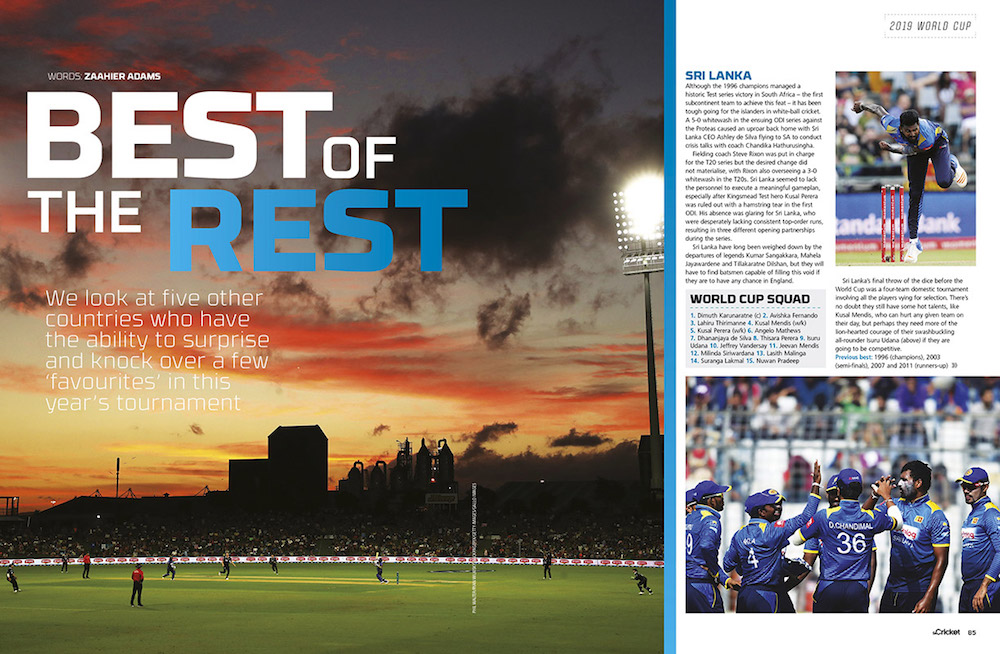We look at five other countries who have the ability to surprise and knock over a few ‘favourites’ in this year’s tournament.
SRI LANKA
Although the 1996 champions managed a historic Test series victory in South Africa – the first subcontinent team to achieve this feat – it has been tough going for the Islanders in white-ball cricket of late. A 5-0 whitewash in the ensuing ODI series against the Proteas caused a major uproar back home, with Sri Lanka CEO Ashley de Silva flying to South Africa to conduct crisis talks with coach Chandika Hathurusingha.
Fielding coach Steve Rixon was put in charge for the T20 series, but the desired change did not materialise as Rixon also had to oversee a 3-0 whitewash in the T20s. Sri Lanka seemed to lack the personnel to execute a meaningful game plan, especially after Kingsmead Test hero Kusal Perera was ruled out with a hamstring tear in the first ODI. Perera’s absence was glaring for Sri Lanka, who were desperately lacking consistent top-order runs, resulting in three different opening partnerships during the series.
Sri Lanka have long been weighed down by the departures of legends Kumar Sangakkara, Mahela Jayawardene and Tillakaratne Dilshan, but they will have to find batsmen capable of filling this void if they are to have any chance in England.
Sri Lanka’s final throw of the dice before the World Cup was a four-team domestic tournament involving all the players vying for selection. There’s no doubt they still have some hot talents such as Kusal Mendis that can hurt any given team on their day, but perhaps they need more of the lionhearted courage of their swashbuckling all-rounder Isuru Udana if they are really going to be competitive.
Previous best: 1996 (Champions), 2003 (semi-finals), 2007 and 2011 (runners-up)
NEW ZEALAND
After Brendon McCullum’s team took the entire island on a thrilling ride all the way to the World Cup final four years ago, the Black Caps will now look to go one step further under the leadership of Kane Williamson. The Kiwis are enjoying their most successful period in international cricket, ranked No 2 in Tests and third in ODIs, and the World Cup is the perfect way for this ‘Golden Generation’ to leave an indelible stamp on the game in their country.
Although McCullum now parades only in various domestic T20 regalia around the world, the core of the 2015 batting unit remains intact, with Martin Guptill, Ross Taylor, and of course, Williamson at the forefront. Taylor, particularly, is enjoying an Indian summer in the twilight of his international career, with the veteran averaging 84.33 over the past 12 months in ODIs.
They are equally threatening with the ball. The 2015 devastating new-ball pair has split up, with Tim Southee primarily a red-ball bowler, but left-arm swinger Trent Boult remains Williamson’s chief strike weapon. Boult has claimed 25 wickets at an average of 25.04 over the past 12 months, and will be eager to show he can deliver in England after a quiet showing at the ICC Champions Trophy two years ago. Southee’s loss has been offset by the emergence of Lochie Ferguson as a genuine strike bowler. The 27-year-old possesses serious pace and has bagged 25 wickets over the same period at 22.48.
New Zealand have a proud record at World Cups played in England, having progressed to the semi-finals on three occasions when the tournament was hosted on British soil. Four years ago, New Zealand united the country when they jointly hosted the global jamboree with Australia. They will attempt to do that again, especially with a greater cause now to play for after the Christchurch mosque attacks that rocked the soul of the peace-loving nation.
Previous best: 1975, 1979, 1992, 1999, 2007 and 2011 (semi-finals), 2015 (runners-up)
BANGLADESH
The most improved team in ODI cricket. The Tigers have long lost their ‘toothless’ misnomer and have continued to climb the rankings since their maiden quarter-final appearance four years ago. They have been particularly dominant in home conditions, losing just one closely contested bilateral series to England (2-1 in 2017,) and a tri-series since the World Cup.
With the bat, Mushfiqur Rahim and Tamim Iqbal lead the way with 674 runs at an average of 51.84 and 442 runs at 63.14 respectively. Left-hander Imrul Kayes has also been prolific during this period, amassing 436 runs at an average of 62.68. Bangladesh’s travels have not brought about similar success, where their bowlers, in particular, have struggled to stem the flow of runs on surfaces that are not conducive to their primarily spin arsenal. Yet, they have shown to be really big tournament players.
Following on from their 2015 World Cup quarter-final showing, they went one step further at the ICC Champions Trophy two later, reaching the semi-finals. It was highlighted by a victory over New Zealand in Cardiff when Shakib Al Hasan (114) and Mahmudullah (102 not out) shared a record 224-run partnership. Knowing that they can play well – and crucially win – in England conditions, will be a major confidence booster for this group of players.
This was also not a once-off performance, with Mashrafe Mortaza leading his gallant side to the Asia Cup in final in Dubai last September. A pre-World Cup tri-series involving West Indies and hosts Ireland should provide a gauge of how this group of players have mentally dealt with coming to within seconds of being involved in the mass shooting at a Christchurch mosque on their recent tour of New Zealand.
Previous best: 2015 (quarter-finals)
PAKISTAN
Can lightning really strike twice? That is the question everyone will be asking after Mickey Arthur’s team surprised all by winning win the ICC Champions Trophy two years ago on English soil. In true Pakistani style, they turned up when it mattered with big victories over South Africa, hosts England (semi-final) and then the coup de grace over India in the final. Unfortunately – possibly even predictably – Pakistan have not managed to sustain that success in bilateral series’ since. Their recent form has been even more concerning. Although they were competitive against the Proteas, they still lost 3-2 in South Africa before Australia inflicted a 5-0 whitewash on the team in the familiar conditions of the United Arab Emirates.
Although the hosts rested key players such as Babar Azam, Fakhar Zaman, Hasan Ali, Shaheen Shah Afridi and Sarfraz Khan, while Mohammad Hafeez was missing injured for the series, Arthur would have wanted to see the team’s bench strength put up a greater fight to maintain the pressure on the incumbents. Test star Mohammad Abbas discovered that ODI surfaces don’t offer the same assistance as the longer format did in his debut series, claiming one wicket at an average of 153.0 in three matches. Junaid Khan’s return to the ODI team did not have the desired effect either, as he too, averaged 44.50, while leg-spinner Yasir Shah was even less convincing, averaging 70.75 per wicket.
The only consolation for Pakistan is that form means nothing to this team. They will still head to England with the belief that they can once again go out and do the business, particularly feeding off the energy from the large British Asian expat community. The format of the tournament will also favour Pakistan. It is a throwback to the 1992 event – which they won – that allows any team a couple of stumbles before hitting peak form.
Previous bests: 1992 (champions), 1999 (runners-up), 1979, 1983 and 2011 (semi-finals)
AFGHANISTAN
This is not just a cricket team, but the symbol of hope for 37 million people in the war-torn nation. Despite some players hailing from refugee camps and having learned the game using a taped tennis ball, they are now heroes.
The Afghanistan Cricket Board was only formed in 1995, but only 22 years later they enjoyed their crowning moment by being awarded Test status in 2017, and then going on to achieve their maiden Test victory just 18 months later.
Considering that it took modern-day powerhouse India 20 years to win their first Test after joining the Test club, the magnitude of their achievement is mind-blowing. For all their success in the longer format, it is white-ball cricket that they really enjoy, and where they pose a genuine threat to the top teams. Many of their leading players, such as Rashid Khan, Mohammad Nabi, Mujeeb Zadran and Zahir Khan Pakteen are sought-after properties in T20 cricket, while others, such as Shafiqullah Shafaq, Mohammad Shahzad, Qais Ahmad and Hazratullah Zazai bubble just under.
The latter, Hazratullah, shot to fame in the Afghanistan Premier League (APL) when he smashed six sixes in an over and equalled the record of Yuvraj Singh and Chris Gayle by scoring a 12-ball half century. The jewel in the Afghanistan cricket crown, though, remains Rashid Khan, with the 20-year-old leg-spinner a global sensation. This will also be Afghanistan’s second appearance at the World Cup after their first outing in Australia and New Zealand four years ago.
This experience, coupled with playing before massive crowds in the IPL on a regular basis, will help a group of primarily young players cope with the pressure of the tournament. Afghanistan are a dark horse that will play an attacking and entertaining brand of cricket that could pull off a couple of major shocks.
Previous best: 2015 (group stage)
This article was written by Zaahier Adams in the latest issue of SA Cricket magazine.
Photo: Phil Walter/Getty Images







